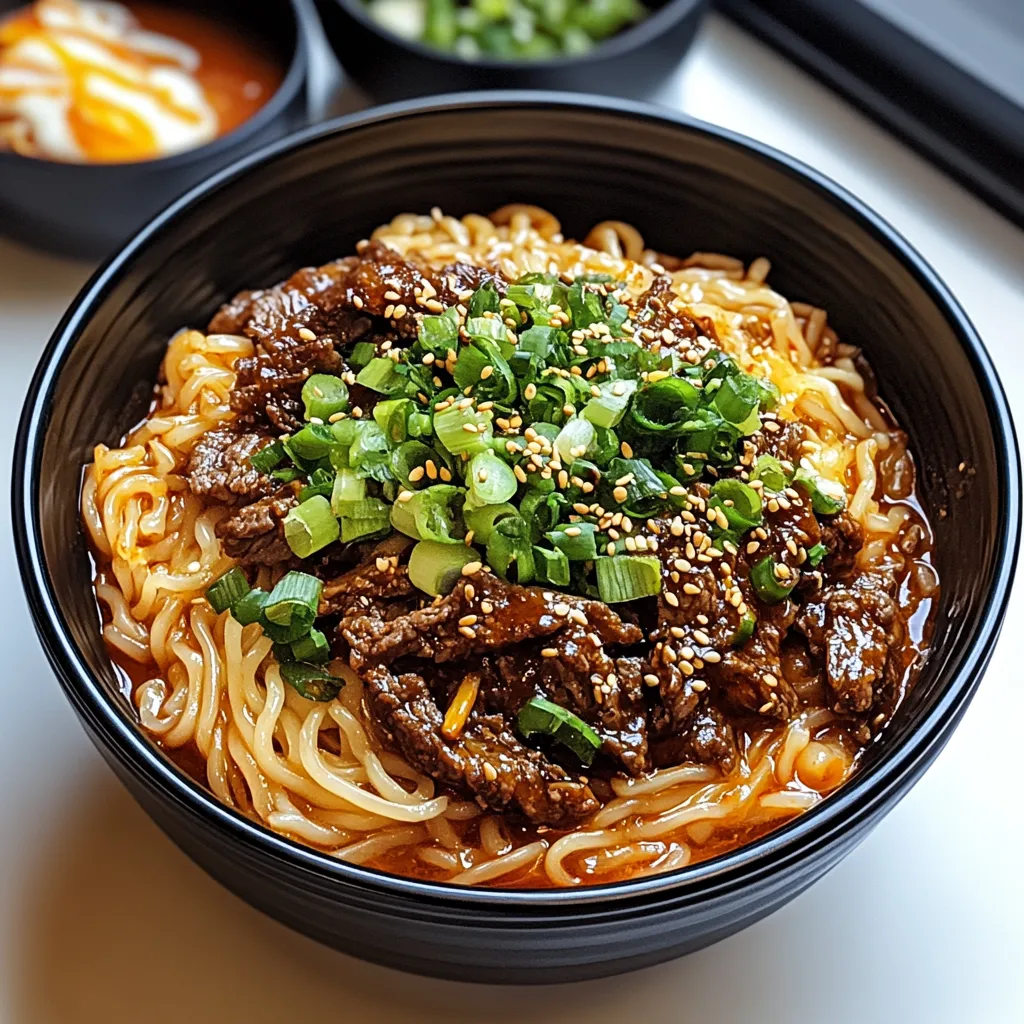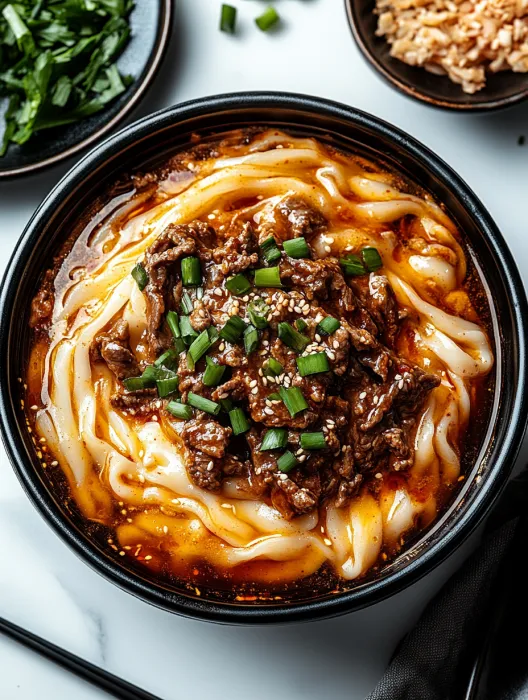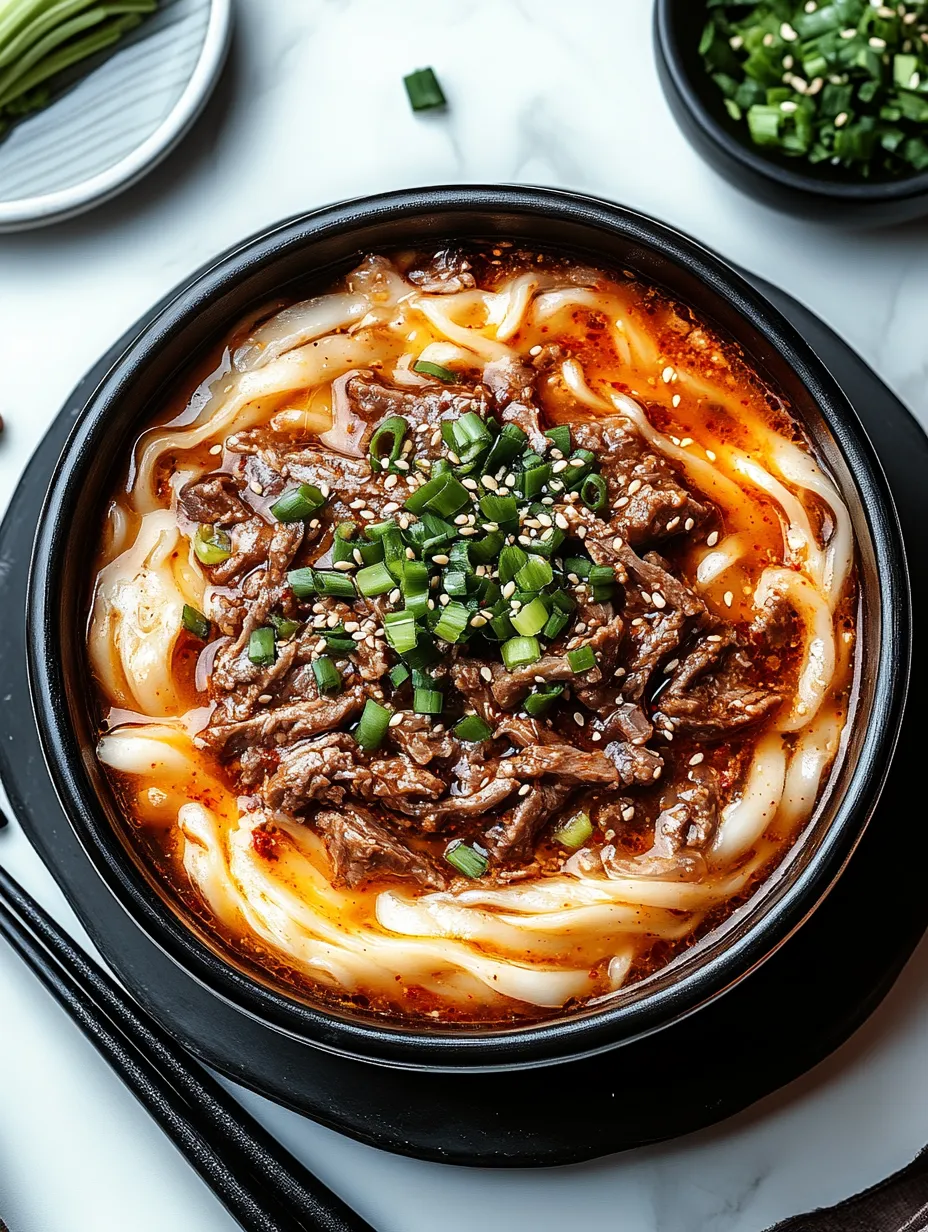 Save
Save
This spicy Korean gochujang beef noodle recipe transforms ordinary weeknight dinners into an explosion of flavors with minimal effort. The combination of tender beef strips and chewy noodles bathed in a sweet-spicy gochujang sauce creates a dish that rivals your favorite Korean restaurant offering but can be made right in your kitchen in just 30 minutes.
I first made this recipe after returning from a trip to Seoul where I became obsessed with the bold flavors of Korean cuisine. After several attempts to recreate that perfect balance of sweet spice and umami richness I remembered from street food stalls, this recipe became my go to crowd pleaser that never disappoints.
Ingredients
- Beef sirloin Use thinly sliced cuts for quick cooking and maximum tenderness. The marbling in sirloin adds rich flavor while remaining relatively lean.
- Gochujang This fermented Korean chili paste is the soul of the dish bringing complex sweet heat. Look for it in Asian grocery stores or the international aisle of well stocked supermarkets.
- Soy sauce Adds essential umami depth to balance the heat. Use low sodium if watching salt intake.
- Brown sugar Creates caramelization and balances the spice. Dark brown sugar offers deeper molasses notes.
- Rice vinegar Provides essential acidity that brightens all flavors. Rice vinegar is milder than other vinegars making it perfect for this dish.
- Sesame oil A finishing oil that brings nutty aroma. A little goes a long way so measure carefully.
- Noodles Medium thickness wheat noodles work best as they hold up to the robust sauce. Udon or even ramen noodles make excellent choices.
- Bell peppers Add color fresh crunch and subtle sweetness. Red ones are sweeter than green varieties.
Step-by-Step Instructions
- Prep Ingredients
- Slice beef against the grain as thinly as possible for maximum tenderness. For easier slicing partially freeze beef for 20 minutes before cutting. Prepare vegetables uniformly for even cooking and visual appeal. Cook noodles until just al dente as they will continue cooking slightly when added to the hot skillet.
- Create The Sauce
- Mix soy sauce brown sugar gochujang sesame oil and rice vinegar in a bowl until smooth. Taste and adjust sweetness or heat according to preference. The sauce should be thick enough to coat the back of a spoon but still pourable.
- Sear The Beef
- Heat your skillet until very hot before adding oil. Cook beef in small batches without crowding the pan to get proper browning rather than steaming. This step takes just 1 to 2 minutes as thin beef cooks quickly. Properly seared beef develops a delicious crust that adds tremendous flavor.
- Build Flavor Base
- Sauté aromatics in the same unwashed pan to capture beef flavors. Cook garlic and onions until translucent but not browned for about 2 minutes stirring constantly to prevent burning. The vegetables should become aromatic and slightly softened while maintaining some texture.
- Combine Components
- Return beef to pan with vegetables and pour sauce over everything. Toss continuously to ensure even coating. Add cooked noodles and fold gently using tongs to incorporate without breaking noodles. The heat should be medium high ensuring sauce thickens slightly and clings to noodles and beef.

Gochujang is my secret weapon ingredient in this recipe. Unlike one dimensional hot sauces this Korean chili paste brings complexity through its fermented flavor profile. My family initially balked at the bright red color assuming overwhelming heat but were pleasantly surprised by its balanced sweetness and gradually building warmth rather than sharp spice.
Perfecting The Spice Level
Gochujang varies significantly in heat level between brands. If cooking for mixed spice preferences start with less than the recipe calls for and add more to taste after tasting the sauce. For those who love extreme heat consider adding a teaspoon of Korean red pepper flakes called gochugaru alongside the gochujang.
The beauty of this recipe lies in its adaptability. Once you understand the basic technique you can adjust the spice level to suit anyone from spice newcomers to heat enthusiasts. Remember that the spiciness tends to intensify as the dish sits making leftovers slightly spicier than when first served.
Authentic Flavor Secrets
Traditional Korean cooking often includes a fruit element to tenderize meat and add subtle sweetness. Adding a tablespoon of grated Asian pear or apple to your sauce creates deeper complexity while helping to tenderize the beef. Most Korean households also keep a container of minced garlic with scallions in their refrigerator called yangnyeomjang that serves as a flavor base for quick meals.
The secret to authenticity lies in balancing the five key Korean flavor profiles sweet salty sour bitter and umami. Our recipe achieves this through brown sugar soy sauce rice vinegar vegetables and meat respectively. These elements working in harmony create that distinctive Korean flavor profile that makes this dish so satisfying.
Serving Suggestions
Korean meals traditionally feature numerous side dishes called banchan. Serve this dish alongside simple quick pickled cucumbers kimchi or a simple cabbage slaw dressed with rice vinegar and sesame oil for an authentic experience. A fried egg with a runny yolk placed on top adds luxurious richness when mixed into the noodles.
For a complete meal experience consider offering small dishes of roasted sesame seeds sliced scallions and extra gochujang sauce on the side allowing diners to customize their bowls. A cold Korean beer or slightly sweet makgeolli rice wine makes the perfect beverage pairing to complement the spicy flavors.

Recipe FAQs
- → What is gochujang and where can I find it?
Gochujang is a Korean fermented red chili paste that adds a sweet, savory, and spicy flavor to dishes. You can find it in the international or Asian food section of most grocery stores, at Asian markets, or online. It typically comes in red rectangular tubs or squeeze bottles and lasts for months when refrigerated after opening.
- → Can I substitute the beef with other proteins?
Yes, you can substitute the beef sirloin with chicken thighs, pork tenderloin, firm tofu, or even shrimp. Just adjust cooking times accordingly - chicken and pork should be cooked through completely, tofu needs less time to brown, and shrimp cooks very quickly (about 2 minutes per side until pink).
- → What type of noodles work best for this dish?
Traditional Korean dishes often use wheat-based noodles like udon or somyeon. However, you can also use ramen noodles, soba (buckwheat), rice noodles, or even linguine as alternatives. Each will provide slightly different texture and flavor, but all complement the spicy gochujang sauce nicely.
- → How can I adjust the spice level?
To make the dish milder, start with just 1 tablespoon of gochujang and add more to taste. You can also mix in a tablespoon of regular tomato paste to dilute the heat while maintaining a similar consistency. For extra spiciness, increase the gochujang to 3 tablespoons or add sliced fresh chilies or a teaspoon of Korean red pepper flakes (gochugaru).
- → Can this dish be prepared ahead of time?
Yes, you can prepare components ahead of time for quicker assembly. Slice the beef and vegetables and store separately in the refrigerator. Mix the sauce ingredients and refrigerate. Cook the noodles, rinse with cold water, and toss with a little oil to prevent sticking. When ready to serve, stir-fry everything according to the instructions. The fully assembled dish keeps well for 3 days refrigerated.
- → What side dishes pair well with Korean Gochujang Beef Noodles?
Traditional Korean side dishes (banchan) like kimchi, pickled vegetables, or spinach namul complement this dish perfectly. For a complete meal, consider serving with simple cucumber salad, steamed broccoli, or a light miso soup. These sides provide contrasting temperatures and textures that balance the rich, spicy main dish.
